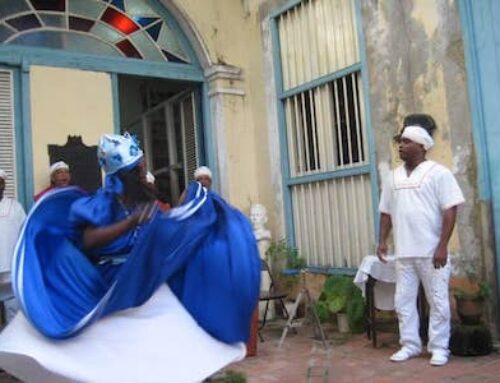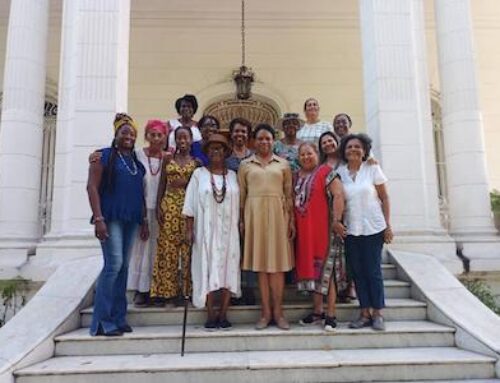In February 2017, Altruvistas collaborated with La Pena Community Chorus on the Choral Exchange to Cuba tour. In addition to visiting Cuba’s cultural sites and learning about contemporary Cuban society, the group met with local choirs and even performed with and for them. We had the pleasure to speak with Elsa Guerra, a La Pena Community Chorus member, on her experience traveling to Cuba.
Altruvistas: Why did you decide to join the Choral Exchange to Cuba tour?
Elsa: We are a community chorus group (La Pena Community Chorus) that has traveled to many Latin American countries including Cuba in 1995. The first trip there was very significant for the chorus and there was always the desire to return to Cuba but for many reasons it was not possible. Within the last 2-3 years we had new possibilities and many new members who had not been in the chorus in 1995. With new energies and hard work on our part, we made it possible to raise the money and create the logistics to do it.
Altruvistas: What were some of the highlights of the trip?
Elsa: Given individual wishes, desires and interests (of the group), there are several that stick out in our minds. For instance, being able to sing La Muralla at the Community Project Todas Las Manos with the people there; learning the history of the project and their relationship with Nicolas Guillén and being gifted with the gorgeous music by the music teacher and the chorus director, gave us tremendous joy and a wonderful experience on our formal 1st full day of activities.
That same afternoon, our visit to the art school, Antonio Caturia Caturia and having the children perform for us the wide variety of instrumental and chorus music and acting was impressive and delightful. The bigger surprise was the children’s reaction to our singing Obatalá, Dulse Embeleso and El Aparecido. All of the above, was topped by the spontaneous dancing by the children and the chorus members, while one of the school’s bands played some beautiful Cuban music rhythms.
The visit to the San Severino Museum was very informative about slavery in Cuba and the Orisha tradition. With luck, when we were ready to perform our ofrenda (song offerings) at the plaza where it is normally done, we were met by a large tour group of abuelas (grandmothers) from Havana. We got to talk to them and exchanged information about our groups and why we were there on that day. Singing Obatalá for them and with them was precious.
The visit to Dolores’ Gardens and the treat to learn about Shangó and Afro-Cuban culture, dance and hospitality was unforgettable. Many of the chorus members accepted their dance invitations and were taught some of the movements and dances of their tradition. Of course we sang Obalatá to the musicians, dancers and community members and with most of them joining us in song. We all could not have thought what a fabulous time we were going to have when we were told we were going to the Dolores Gardens!
Singing with the Coro Nacional de Cuba with its director Digna Guerra at the Terrace of ICAP was very emotional for all of those who were in Cuba in 1995. Being gifted with the music, dancing and singing of the Grupo Vocal BaoBao was the icing on the cake. It was so much fun for everyone to sing and dance together after their presentation.
Every meeting with other choruses we had was phenomenal and we were very impressed with the lovely arrangements and music we were presented with. We learned from them and hope that sharing our music with all those musicians was also enjoyable for them as well.
Altruvistas: How has visiting the country help you understand the place, culture and/or issue(s) more?
Elsa: The broad program prepared for us by Altruvistas, ICAP and Amistur presented the opportunity to learn, experience, enjoy and generally, know and understand a bit more about the many facets of Cuban culture and history. Every presentation we attended on the arts, history, culture etc., was done by very capable and knowledgeable presenters. During our 10 days there, we acquired a much better understanding of the complexity of life in Cuba
We understand we were only able to skim the surface but certainly it was a more clear and factual understanding of the realities of a Cuba seen from within.
Altruvistas: After this trip, what are some insights you have about yourself, your country and/or the world?
Elsa: Again, this is a very personal response and I will do it from my own perspective. Although, discussing these matters with some of my chorus mates, we all agreed on the fantastic quality of our experiences on this trip.
After seeing, hearing and learning about the life of regular people in Cuba from all the common experiences we had as a group and from the personal conversations with individual people I had the opportunity to converse with during my stay, I came to the conclusion that Cubans are very happy people.
In my opinion, the fact that the basic necessities of life are part of what every Cuban has daily: a roof over their heads, food to eat, medical coverage, free education and work, makes for living a life with a minimum amount of stress compared to that of Americans. This does not mean that Cubans have an abundance material things. In fact, they have very little of everything but they appreciate what they have.
I found most Cubans to be very generous and kind with others. They are happy people who treasure and relish their history and their culture. I found myself many times talking to a particular person and feeling that at that moment, I mattered to that person. I had their total attention and interest in the conversation we were having. By looking directly at me with warm smiles in their eyes and their faces when we conversed, they crushed my heart with happiness every time. I found that Cuban people are not only concerned about their families, but they are concerned about their communities and all other human beings in need. I sense that community for Cubans means all of Cuba and includes all the regions and people that make the country what it is.
To finish this long response to your question, personally I feel Cuba could be seen as a model of how countries, communities and individuals can work to make life safe, fulfilling, kind, and effective for all people. The example of the Literacy Project and the accomplishments achieved in that one year, in which it was envisioned is an amazing model to follow. Having a clear understanding of what is needed, the goal of what to accomplish and input from the people affected by this and to create a new reality is doable. Not easy, but starting within the community, we can make things happen.
The gift of happiness that I experienced in Cuba stays with me a bit longer. I decided to be happy every day. When I go out on the street, I acknowledge everyone that is on my path, look at the individual in the eyes and greet him or her with a smile. To my delight, I get a nice smile and a greeting in return. For that, I feel I am making a difference.
Altruvistas: What are some of your concerns about the country?
Elsa: Some of my concerns are:
- That tourism with all its financial benefits is also changing the nature of Cuban culture. The disparity of opportunities to make more and/or some money for anyone involved in this industry will have a great effect on the equality for all Cubans.
- The growing personal enterprise of having a casa particular (private accommodation in local homes) where money is made regularly has the same results as #1.The problem in Havana with the different ways one owner of an apartment is able to maintain, paint, and keep in good shape his/her apartment because the owner has relatives in Miami who send money to them on a regular basis compared to another owner who does not have that privilege. In my opinion it isn’t healthy neighborly living which with time can be very complicated. This for me was surprising, since I know how important community is for everyone in Cuba. There are ways (rules?) to conduct oneself in the general districts/barrios/neighborhoods but that seems different when you live in a multi-level apartment building. Perhaps I did not understand fully this problem but given the general housing conditions Havana and the lack of funds to support those that do not have the resources to work on their apartments, it is a problem that needs attention.
- And one last concern, I know that there is a big effort being made to keep the youth safe and engaged in healthy living. I am concerned that many young people now are being exposed to tourists, television, Miami, etc., increasing their appetite for material goods and work opportunities that are not available to them now. This will only increase with time. The danger of young people leaving the island for a “better life” is very strong.
The general age of most decision makers in the government and for the country tends to be fairly older. Young people need to be involved in creating new paths that Cuba needs to sustain their culture and way of life.





